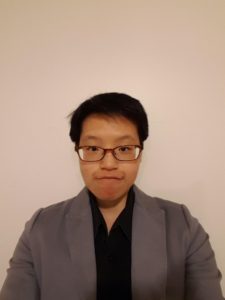Three of Camosun’s recent Medical Radiography diploma program graduates have been awarded the Governor General’s Collegiate Bronze Medal. The medal is awarded to students who have the highest overall average at graduation of a diploma-level, post-secondary program. The students—Kelsey Houston, Kasi Schnablegger, and Mel Tsai—achieved a 9.0 grade point average, the highest possible.
Tsai—who volunteers with the Canadian Association of Medical Radiation Technologists (CAMRT) to develop a new online course focusing on how medical radiation technologists can provide better care for people who are part of the LGBTQ2+ community—says that smaller class sizes played a role in their success, but some time at UVic, which Tsai previously attended, also helped prepare them for the program.
“At UVic, you had to do a lot more on your own, and then having that support from my [Camosun] instructors, compiled with the work ethic, really helped,” says Tsai.

Tsai’s academic background in anatomy and physiology is part of what made them realize they wanted to go down the radiography path.
“That was definitely my favourite part of the course,” says Tsai.
Because of the nature of the job, someone practicing the profession could be the first to see a severe health ailment on a scan, which puts radiographers in a unique position, says Tsai.
“Radiographers are the first people who see what’s on the x-ray before any of the doctors, really, and then at the same time, we’re not trained to diagnose. Radiographers—we have a poker face.”
If they see something alarming on a scan, Tsai says they try to cope with that by thinking about what is best for the patient.
“If I see something that’s really serious, or something that really needs immediate attention, I would, in that case, actually go to the radiologist and I’d tell them that there’s a scan they should be seeing right away, so that way the patient isn’t going home with this really serious condition,” they say.
During their time as a student, Tsai spoke up a couple times about LGBTQ2+ issues; around the time of graduation, the opportunity came up with CAMRT. Inequality in general perpetuated with colonization, says Tsai, but now people can find different views on gender and sexuality.
“I got to meet other technologists that are also really passionate about this issue, and we’ve connected more people, because during the program, that really wasn’t a thing,” says Tsai.
A really simple thing that we can all do to help progress equality in society is introduce ourselves with our name and our pronouns, says Tsai.
“Don’t make assumptions, on a general basis. You don’t know someone’s gender,” they say. “You don’t know what their pronouns are just by looking at them.”
Tsai worked hard on their studies, about six to eight hours a day—a fairly normal day, they say—but they would also multitask and work during class.
“I would work during class, as well as once I got home. In between breaks I would be looking at my notes; also at home I would be studying for tests or making notes trying to stay on top of the course material.”
Because of the pandemic, says Tsai, there is a little more recognition in general about the importance of the health-care system.
“Radiographers are people who are in very much essential [work], and they’re willing to do a lot to get the best quality images possible,” says Tsai. “And also, at the same time, taking care of the patients. Part of being a radiographer is really being able to adapt, so I think those things have been put to the forefront.”
